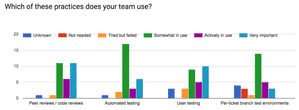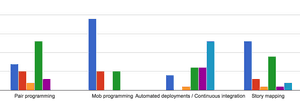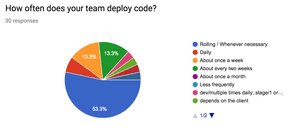Tuesday, 23 January 2018
Practices - Amazee Agile Agency Survey Results - Part 9
This is part 9 of our series processing the results of the Amazee Agile Agency Survey. Previously I wrote about client interactions; this time let’s focus on practices. How often do teams deploy code? Are they practising peer reviews, automated testing, pair programming or story mapping? When asked about “How often does your team deploy code?”, 53% of the teams answered they would do deployments “Rolling / Whenever necessary”. 13.3% deploy “About once a week”, another 13.3% “About every two weeks” and 6.7% answered they would deploy “Daily”. The remaining chose to go with freeform answers such as different frequencies based on the dev/stage/live environments or that it would depend on the client.
For us at Amazee, the deployment schedule depends on the needs of the clients. Thanks to the automatization that our Amazee.io hosting environment provides, any team member can execute a deployment on their own if it makes sense. Some High-availability clients require a fixed deployment schedule that our team has programmed to happen every week, besides that only critical hotfixes would be deployed instantly out of the schedule. Most of our clients allow us to deploy whenever, yet if a downtime for more complex deployments is needed we usually try to schedule them outside of business hours. For global customers that run their website across the globe, we try to find the deployment slot that fits best and rely on a proxy server like Varnish that keeps serving anonymous users during a deployment downtime.
Our second question was geared towards finding out which agile practices would be used by teams and how important they are considered. Contestants were able to rate from “Unknown”, “Not needed”, “Tried but failed” to “Somewhat in use”, “Actively in use” up to “Very important”. The practice that was mostly unknown is Mob programming. Story mapping is also widely unknown but also has a good number of constants rating it with “Somewhat in use”. Pair programming is somewhat in use for many but also has a good number of contestants who responded “Unknown” or “Not needed”. The practices mostly rated as “Very important” where Peer reviews/code reviews as well as User testing. Automated testing got a lot of votes for “Somewhat in use”, and a few ones rated it as “Very important”. Per-ticket branch test environments have been rated as “Somewhat in use” by many as well.
For us at Amazee, we do Peer & code reviews for every work increment within our Scrum teams. This ensures code quality, knowledge transfer and feedback between team members. Automated testing happens for mission-critical features. Vasi has an article with good arguments why you should invest in it. User testing is performed on about a third of our projects. Automated deployments, continuous integration and per-ticket branch test environment are extensively used thanks again to the Amazee.io hosting environment goodies. Pair programming is quite common for our teams. While we have experimented with mob programming for teaching purposes, our team didn’t entirely pick it up. Finally, story mapping is something that we started using recently with good results, but we don’t have too much experience with it, yet. Which practices do you use and how often do you do deployments? Please leave us a comment below. If you are interested in Agile Scrum training, don’t hesitate to contact us. Stay tuned for the last post where we’ll do a round up of the Agile Agency Survey.



